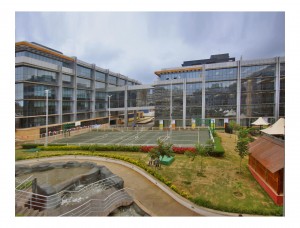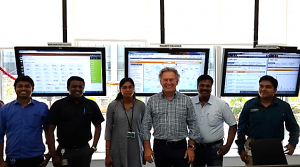































Seven years ago, many people (including my mother-in-law) thought I had made a career-ending decision to accept a high-risk assignment and relocate to India. My mission: build from the ground up Cisco's second headquarters, a Globalization Centre East in Bangalore focused on innovation, talent and partner development that envisioned 10,000 employees in three years, including the top 10% of worldwide talent. My charter included developing a world-class technology campus that also served as a showcase for incubating and advancing Smart City services worldwide, and to become the most relevant ICT company in India.
Was it the right decision?
 Although half a world away from Cisco's corporate headquarters in the Silicon Valley, I thought the new job was still full of great promise. India was and still is the world's largest democracy, had a growing talent pool, a zest for innovation, a co-operative government, aspirational middle class and a potentially huge economy purring along at 8% annual growth.
Although half a world away from Cisco's corporate headquarters in the Silicon Valley, I thought the new job was still full of great promise. India was and still is the world's largest democracy, had a growing talent pool, a zest for innovation, a co-operative government, aspirational middle class and a potentially huge economy purring along at 8% annual growth.
In four years, we partnered with national and local governments as well as an ecosystem of commercial businesses to architect and develop a fully networked campus.The Smart + Connected Community inBangalore integrated building systems with IT systems and applications onto one IP network, enveloped by artfully designed buildings and collaborative work spaces.
Today, the 1-million-square-foot Globalization Centre East campus employs more than 11,000 people, houses Cisco's Research and Development, IT and customer support teams with the best talent in industry. The campus also meets my original charter as the incubator for validating our industry-leading Smart + Connected Communities, especially Smart Cities, which today has projects on nearly every continent worldwide, encompassing more than 90 engagements.
as the incubator for validating our industry-leading Smart + Connected Communities, especially Smart Cities, which today has projects on nearly every continent worldwide, encompassing more than 90 engagements.
All that has been extremely rewarding to see, but was it the right decision?
We achieved every critical objective except one: growing ICT technology throughout India itself. In my four years of living in India and after a number of subsequent trips revisiting there, I now realize that the promise and opportunity of India can be unpredictable. After several years of nearly double digit growth, India's economy spiraled down, experienced high inflation, a weakening rupee, allegations of government corruption and financial policy decisions that spooked the international investment community.
While there was appreciation all around for what it could do, IT penetration for many companies in India is still abysmally low. For many global IT majors, India still accounts for a small percentage of global revenue. This disappointing irony in India has come at a time when we at Cisco have been meeting or exceeding our IoE and technology goals elsewhere around the world in both the public and private sectors.
However, just when global investors had written off India, the enterprising country surprised the world again. In the recent election, and against the odds, voters elected Prime Minister Narendra Modi and gave a majority to a single party. Their platform, including "minimum government and maximum governance through technology," seeks to digitize the entire country to create new jobs and connect more people with healthcare, banking, education and even food (agriculture). For example, the Government of India recently unveiled a budget that commits significant investments to develop 100 new Smart Cities.
In my last trip to India just two weeks ago, I met a cross section of senior leaders of the new Government, top industrialists, economic think tanks, Cisco employees and people at large. The excitement in the country was palpable. It appeared that the entire country has embraced the BJP party campaign slogan, "Good days are ahead." The collective conscience of the 1.3 billion population seems to have awakened to the full potential of India, which will be home to one-third of the world's workforce in a few decades.
I had the opportunity to explain to leaders Cisco's calculation that the Internet of Everything can unleash some$19 trillion of economic value in both private and public sectors worldwide over the next decade,$500 billion of which can happen in India.
economic value in both private and public sectors worldwide over the next decade,$500 billion of which can happen in India.
So, did I make the right decision to "Go East" and commit to India?
I realize now that transformational changes take time, but that time clearly is now. Once again, India's and Cisco's objectives are fully aligned around the expanding reality of the Internet of Everything -connecting people, places, data and things to improve how we live, work, play and learn. Promise now appears to be marching toward performance.
The Government and its policy shifts coincide with another major transformation at Cisco -a wide range of innovations and technology advances at the Globalisation Centre East that I jumpstarted in Bangalore. The campus has evolved into a living lab that demonstrates every day Cisco's vision of the "future of work", showcasing new-generation solutions for Workspace Management, Energy, Indoor Navigation Apps, Sign-based information, Creativity Zones, Connected Transportation and Emergency Notification, among others.
Newly upgraded buildings feature fully networked smart parking, an Indian marketplace, a British village, connected cafes, recreation and relaxation rooms, a rooftop solar power system and indoor "neighborhoods" all designed for workers to quickly meet (in person or virtually), in order to collaborate, innovate and deliver wherever they are located.
More about this highly advanced workplace community will be revealed next month, but Globalisation Centre East clearly has become the "smartest" of Cisco's smart communities, where connecting the unconnected creates a more flexible and stimulating work environment, reduces our carbon footprint, lowers costs and provides more sustainable operations.
Reflecting on my recent trip, I was doubly gratified by the new phase of Cisco's campus and the recognition by new Government leaders to understand the role that technology can play in transforming India. I think the nation has re-discovered its focus, confidence and its tryst with destiny.
In 2007, I saw plenty of promise. In 2014, all signs in India point toward improving performance through the Internet of Everything. We look forward to our long-term engagements with the Government and our partners to help overcome economic, social and environmental challenges. This is clearly the right decision -then and now. Even my mother-in-law acknowledges it!
Follow me: @wimelfrink
 Tags quentes :
Internet of Things (IoT)
Internet of Everything (IOE)
Cidades Inteligentes
india
Information and communication technologies (ICT)
Smart + Connected Communities
Bangalore
Narendra Modi
Globalisation Centre East
Tags quentes :
Internet of Things (IoT)
Internet of Everything (IOE)
Cidades Inteligentes
india
Information and communication technologies (ICT)
Smart + Connected Communities
Bangalore
Narendra Modi
Globalisation Centre East